Japanese knives are renowned for their exceptional craftsmanship and precision cutting ability, making them a favorite among professional chefs and culinary enthusiasts alike. Originating from centuries-old techniques used in samurai sword making, these knives are distinguished by their sharpness, durability, and elegant design. Each type of Japanese knife is purpose-built to excel in specific tasks, from the delicate art of slicing sushi to the robust demands of chopping vegetables.
When searching for the best Japanese knives, it’s critical to consider the type of steel, blade shape, and balance. High-carbon steel is often favored for its ability to maintain a sharp edge, but it requires careful maintenance to prevent rust. The shape of the blade influences the knife’s versatility and suitability for different cuts. For instance, a Santoku knife offers a well-rounded option for various chopping, slicing, and dicing tasks.
In making a purchase, attention should also be paid to the knife’s handle, as comfort and grip can greatly affect cutting precision and safety. Choosing a handle that fits well in your hand and provides the right weight distribution alongside the blade will enhance control during use. Lastly, the authentic craftsmanship behind each knife can signify its quality, as traditional methods are still used by some artisans to produce these culinary tools.
We have dedicated numerous hours to examining and testing a wide range of Japanese knives to help you find the ones that mince, slice, and dice with ease, elevating your culinary experience.
Table of Contents
Top Japanese Knives
In our pursuit of precision and craftsmanship in the kitchen, we’ve curated a selection of the finest Japanese knives available. Renowned for their exceptional sharpness, balance, and durability, these blades epitomize the artistry of Japanese blacksmiths. Our list embodies the perfect tools for professional chefs and culinary enthusiasts alike, promising to elevate your cooking experience with their unparalleled performance.
MITSUMOTO SAKARI Gyuto Knife
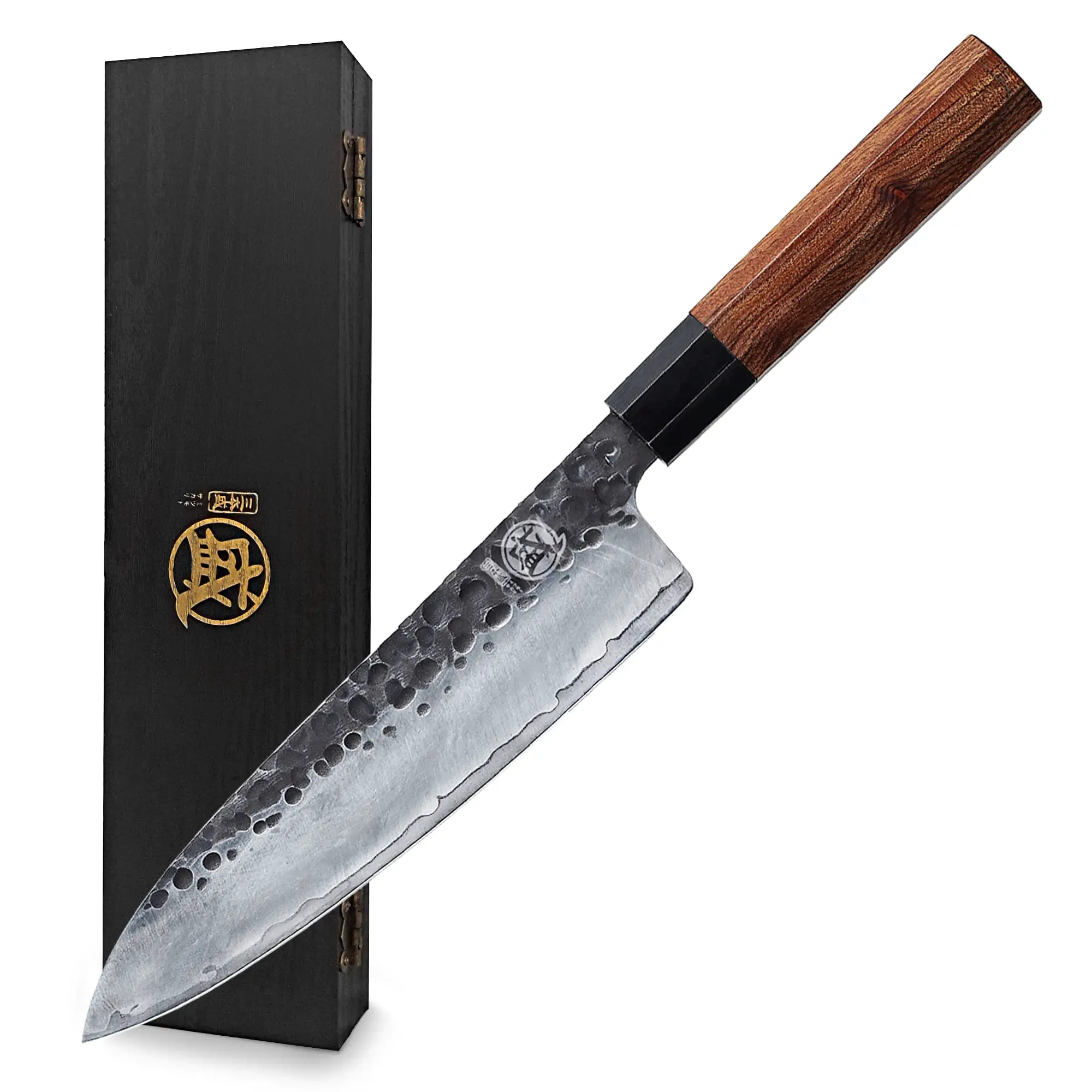
We believe serious cooks will appreciate this knife for its sharpness, craftsmanship, and traditional aesthetic.
Pros
- Exceptionally sharp, making precision cuts effortless
- Comfortable, ergonomic handle that eases wrist tension
- Aesthetically pleasing with a hand-forged, textured finish
Cons
- Not dishwasher safe; requires careful maintenance
- May be prone to chipping if used improperly due to high hardness
- Higher price point than some entry-level knives
After spending time with the MITSUMOTO SAKARI Gyuto Knife, it’s clear that it hits all the right notes when it comes to prepping ingredients quickly and accurately. The traditional hand-forging technique and the ultra-thin blade are a testament to its Japanese heritage, enhancing both the beauty and functionality of the knife.
The high carbon steel is a standout feature, ensuring the blade holds its edge through busy dinner preparations and intense chopping sessions. Yet, it’s not just about sharpness; the rosewood handle feels balanced and snug in our hands, giving us the confidence for swift, accurate slicing without strain or discomfort.
Nevertheless, this knife does come with its need for respect and care. The blade’s sharpness and high carbon content means it’s essential to hand wash and dry immediately to maintain its integrity. Despite this, the overall craftsmanship and performance make the MITSUMOTO SAKARI Gyuto Knife an excellent investment for those who take their cooking seriously.
Shun Sora Chef’s Knife
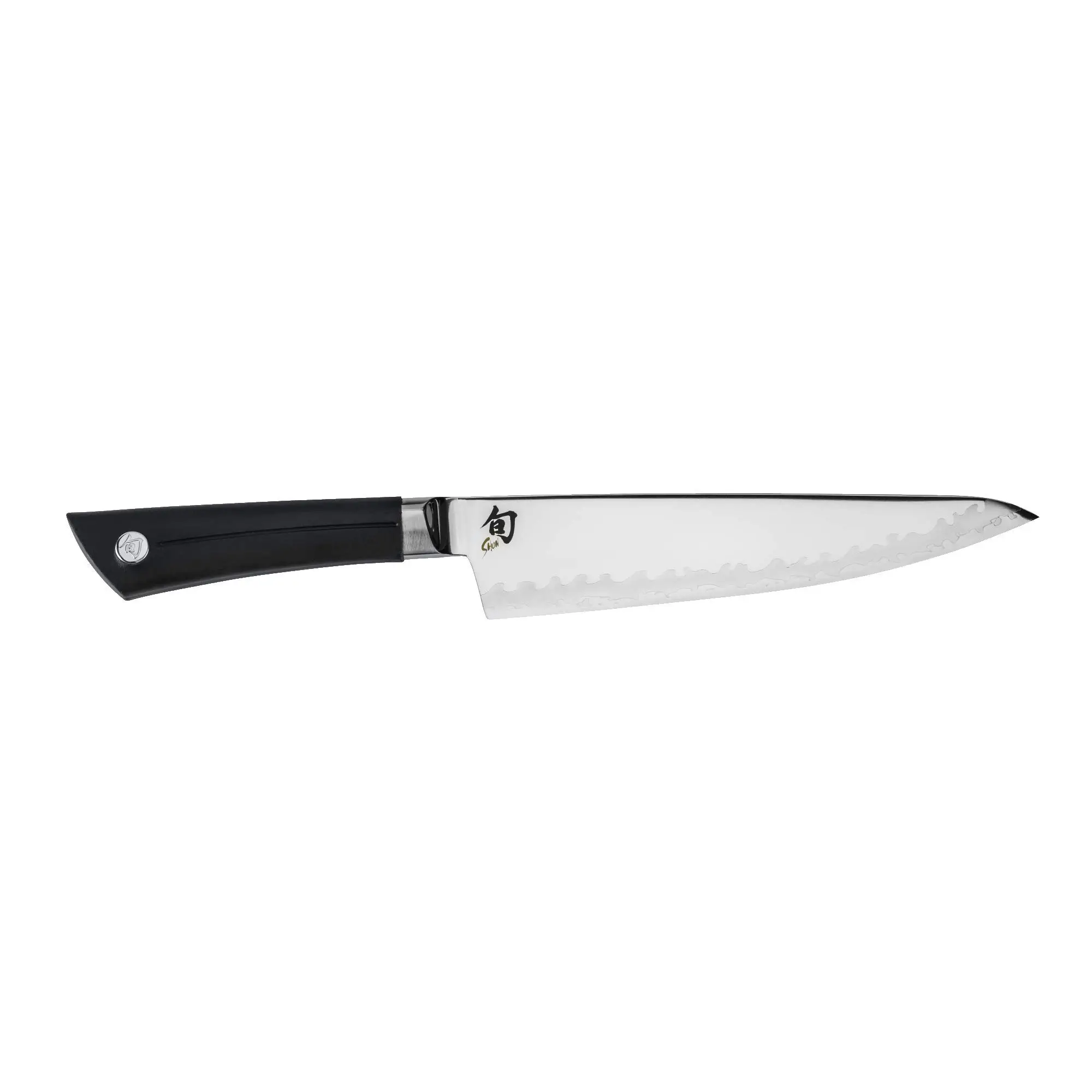
We believe this Shun Sora Chef’s Knife is an exceptional choice for anyone passionate about cooking due to its precision cutting and enduring sharpness.
Pros
- Ideal for an array of food preparation tasks
- Maintains a sharp edge with high-quality steel construction
- Balanced and ergonomically designed for comfort
Cons
- Higher price point compared to some other brands
- Not dishwasher safe, requiring careful manual cleaning
- Handle material may feel less premium to some users
When we took this knife into our kitchen, its performance was impressive. The less-curved blade allowed us to chop with remarkable efficiency—the entirety of the blade met the cutting board, slicing through vegetables and meats with ease.
Prep work felt less like a chore and more like a seamless dance; the knife’s agile handling encouraged a rhythm that had us dicing through ingredients in no time. And that gentle roll off the tip? It meant smooth cuts and fewer lifts, increasing both safety and speed.
However, our experience was slightly marred by realizing that such a fine instrument requires equally fine care. It’s not suited for the rigors of a dishwasher, and the handle, while sturdy and comfortable, doesn’t exude the same handcrafted luxury as its blade. It’s a knife that demands respect and care—quite right for such a functional piece of art.
After multiple uses, the blade retained its sharpness admirably. Sharpening was seldom required, which speaks volumes about the quality of VG10 steel. It’s an investment for sure, but one that any serious home chef should consider. The balance in the hand felt just right, making tasks that require a steady grip and precision, such as filleting fish, feel effortless.
Ompusos Kiritsuke Chef Knife
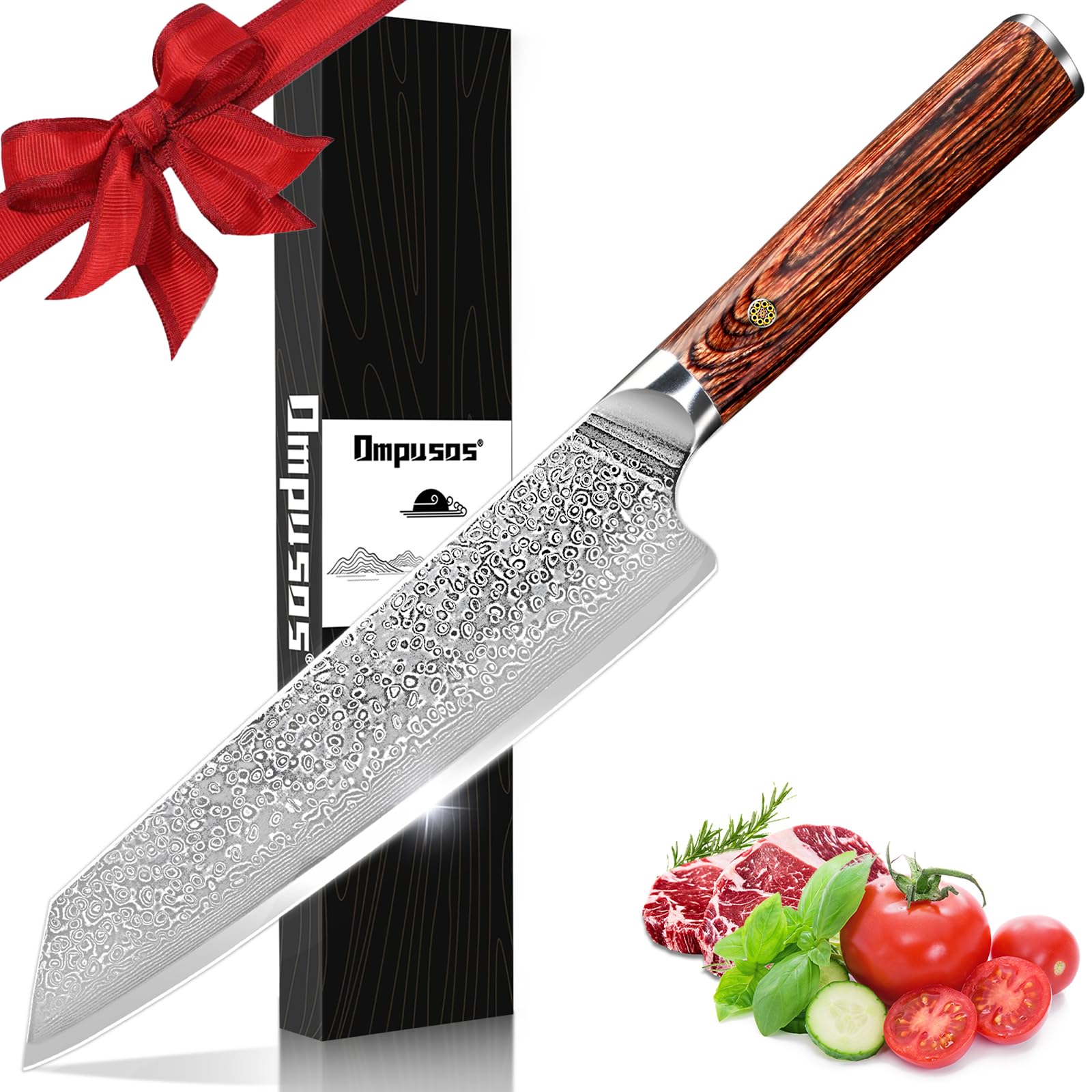
We believe this knife is a great addition to any kitchen due to its sharpness, design, and ergonomics.
Pros
- Exceptionally sharp edge right out of the box
- Handle design offers a comfortable grip for extended use
- Comes with a striking pattern and a presentable gift box
Cons
- The steel quality may not be true Damascus as advertised
- Handle received may differ from the image shown
- Some users might prefer a heavier knife for more robust tasks
In our use, the Ompusos Kiritsuke Chef Knife became an immediate asset in the kitchen. The first thing you notice is the beautiful pattern across the blade, which isn’t just for show — it glides through vegetables and meats with ease. The edge retention has been impressive, maintaining its sharpness through various tasks.
Handling the knife feels like an extension of our arm, primarily due to the well-crafted ergonomic wood handle. Whether dicing onions for long periods or slicing through a tough cut of meat, our grip remained comfortable and steady, which speaks volumes about the design consideration put into this knife.
Finally, the presentation of this knife can’t be overlooked. Housed in an elegant gift box, it makes an excellent gift for anyone who appreciates the art of cooking. Although there were some discrepancies in the handle color received versus what was shown, it was a minor issue and did not detract from the knife’s performance or aesthetic. Overall, using the Ompusos Kiritsuke Chef Knife has been a delightful experience.
Shun Premier 8″ Chef’s Knife
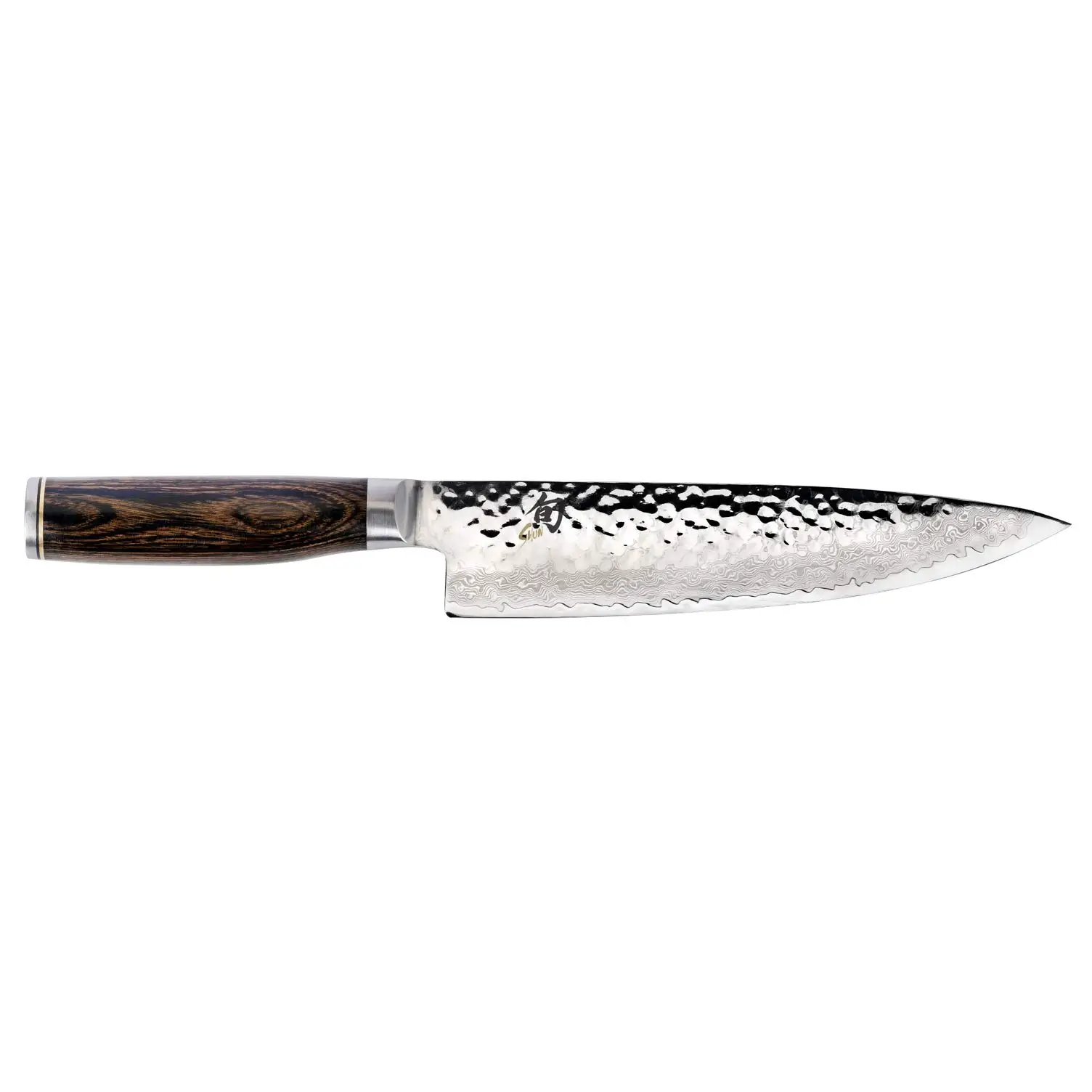
We believe this knife is a wise investment for anyone passionate about cooking, given its exceptional sharpness, balance, and craftsmanship.
Pros
- Effortless slicing through various ingredients
- Comfortable grip and well-balanced design
- Exquisite, sharp aesthetic that enhances the kitchen
Cons
- Price point may be steep for casual cooks
- Requires careful maintenance to preserve edge
- Might be too sharp for inexperienced users, posing a safety risk
Having recently prepared a meal using the Shun Premier 8″ Chef’s Knife, we were impressed by its sheer performance. The wide blade combined with a gracefully curved edge made rocking through herbs and chopping vegetables an absolute joy. Each slice felt precise, almost as if the knife anticipated the motion through the ingredient.
Upon handling the knife, we were also taken with the Pakkawood handle. Not only did it provide a comfortable and secure grip, but it also gave a sense of robust control over the blade – critical when tackling more intricate cuts. The knife felt like an extension of our hands, responding with agility to every maneuver.
The knife’s stunning design cannot be overlooked. With its hand-hammered finish and Damascus pattern, it was as much a work of art as it was a culinary tool. It brought a touch of elegance to the kitchen, making the mundane task of prepping ingredients feel like a luxurious experience. But, it’s not just about good looks; after several uses, the blade remained as sharp as the day it arrived, speaking volumes about the quality of its construction.
In our kitchen, the Shun Premier Chef’s Knife has proven to be more than a mere accessory; it is an indispensable ally in our culinary creations. We’ve seamlessly integrated it into our daily routine, and it’s hard to imagine returning to lesser knives after experiencing such superior performance.
MITSUMOTO SAKARI Damascus Chef Knife
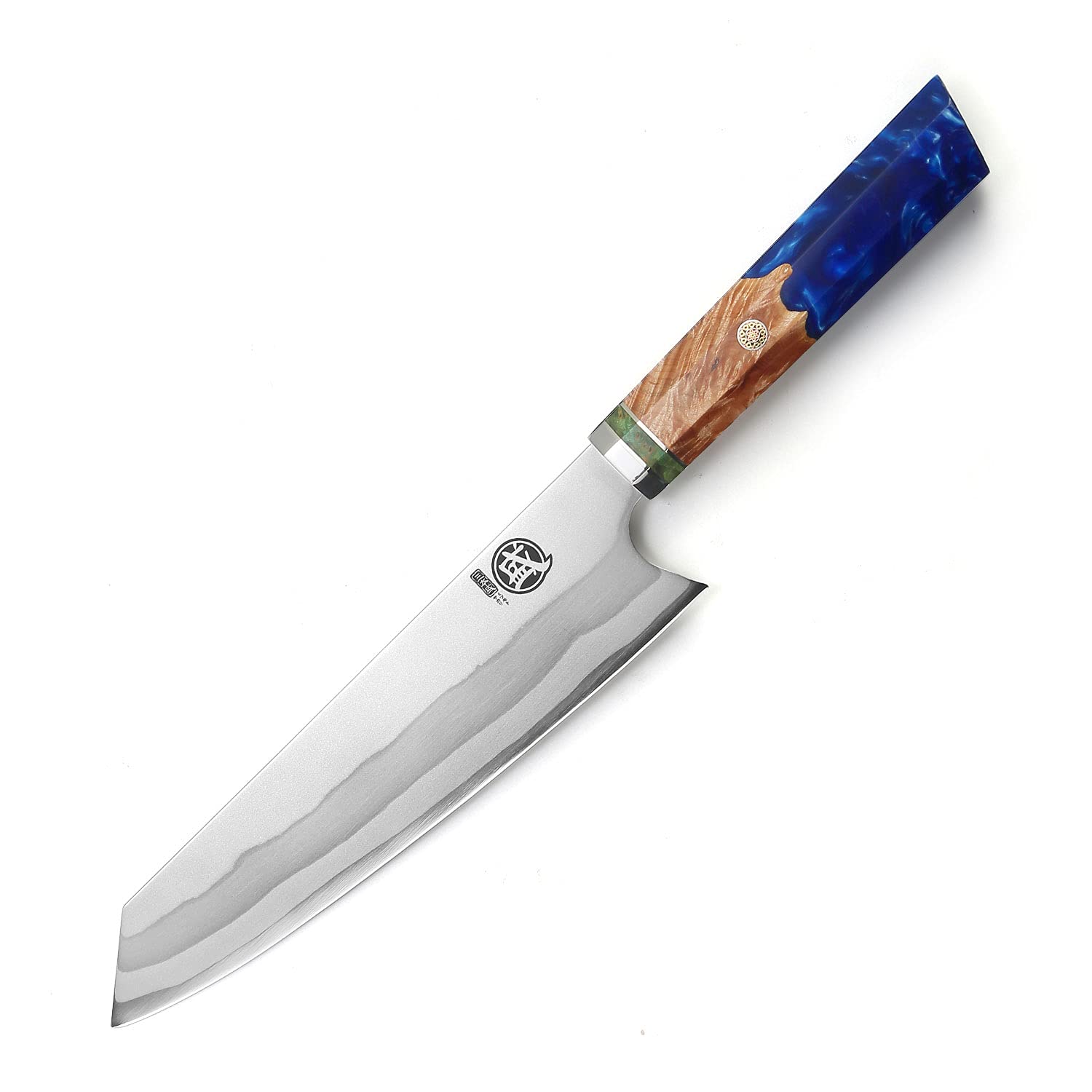
We believe this MITSUMOTO SAKARI Chef Knife is a worthy addition to any kitchen, offering a seamless blend of aesthetics and functionality.
Pros
- Exceptionally sharp and durable
- Unique, visually appealing handle design
- Well-balanced for precision cutting
Cons
- Handle may require extra care for longevity
- Not dishwasher safe; hand wash recommended
- Premium pricing may not fit all budgets
This Japanese Kiritsuke knife from MITSUMOTO SAKARI struck us with its striking blue pomegranate handle as soon as we unboxed it. The 67 layers of 440C Damascus steel provide a cutting experience that is smooth and efficient. This blend of traditional craftsmanship and modern materials culminates in a blade that maintains a razor-sharp edge even after considerable use.
Handling the knife, we were impressed by its optimal balance. It feels like an extension of the hand while chopping, slicing, and dicing a variety of ingredients. From delicate vegetables to tougher meats, the knife performed with precision. The 8-inch blade glided through the food, and the slight curve to the edge facilitated a rocking motion that’s ideal for mincing herbs.
Aesthetics are another high point of this product. The dazzling handle isn’t just a pleasure to look at; it also offers a comfortable grip that doesn’t slip, even when wet. During a busy cooking session, this proved invaluable. However, we noted that the beauty of the handle requires careful maintenance to preserve its unique pattern and coloration, so it’s wise to avoid any harsh detergents or dishwashers.
In conclusion, this MITSUMOTO SAKARI Chef Knife is a testament to Japanese knife-making skill. It’s not just a tool; it’s a conversation piece that combines functionality with art. Despite the higher price tag and some care requirements for the handle, we regard this knife as an investment for those passionate about cooking and looking to elevate their culinary experience.
ASETY Damascus Knife Set
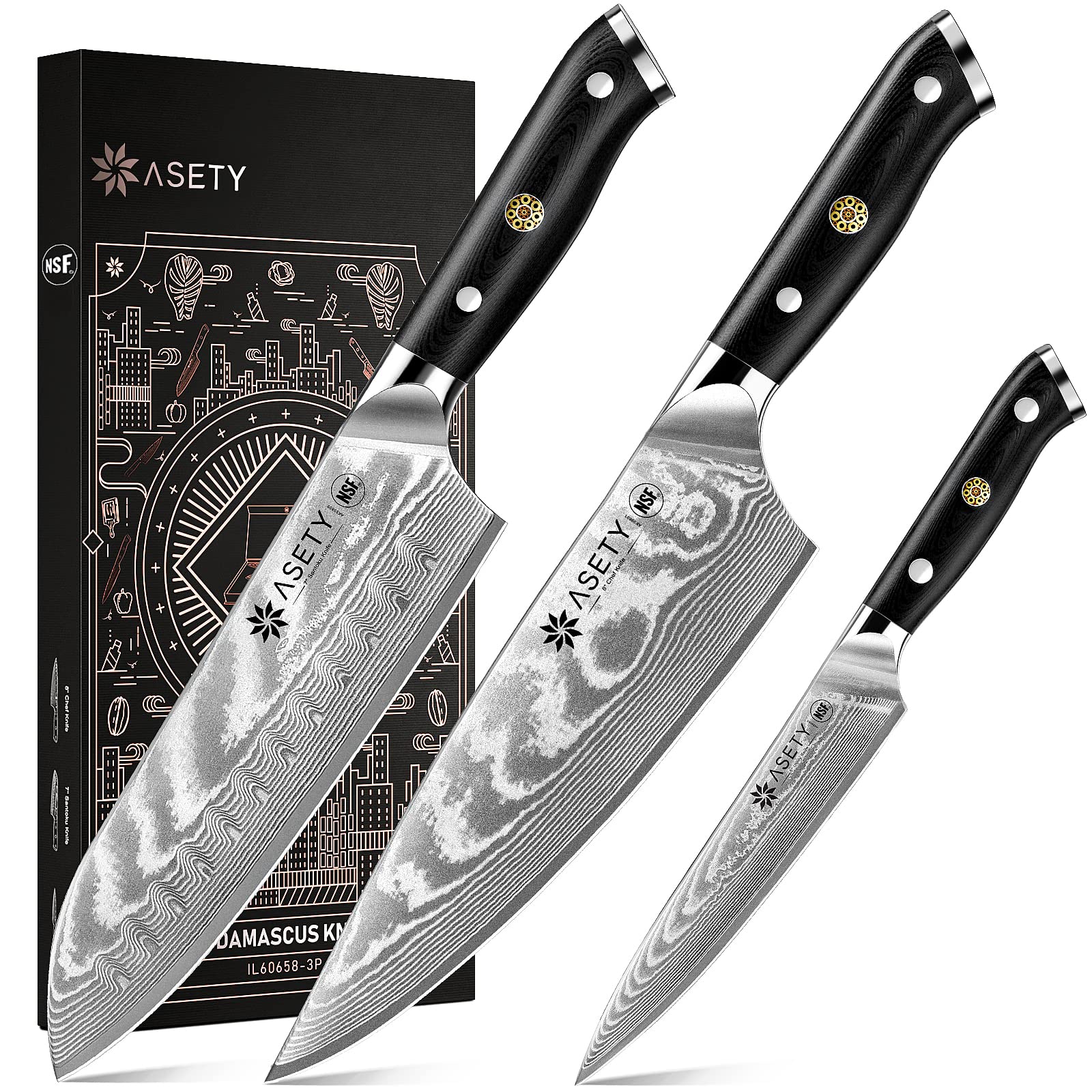
If you’re eyeing top-tier sharpness and durability in your culinary arsenal, this knife set is a cut above the rest.
Pros
- The sharpness right out of the box is stellar for precision cuts.
- Ergonomic G-10 handles offer comfort during long prepping sessions.
- Full tang construction ensures strength and balance in hand.
Cons
- The longevity of the edge retention is yet to be tested over many years.
- Pricier than average sets, a consideration for budget-conscious buyers.
- The aesthetic appeal of Damascus might not be for everyone.
Having recently experienced the ASETY Damascus Knife Set in action, it’s clear that these blades are more than just kitchen tools; they feel like an extension of our hands. The delicate balance afforded by the comfortable G-10 handles made quick work of dicing onions, and the full tang construction provided a reassuring sturdiness that we didn’t realize we were missing.
The 67-layered 10Cr15CoMoV steel was a thing of beauty, gliding through tomatoes with a surgical precision that left us impressed — and without a squished tomato in sight. This set had us feeling like seasoned chefs, even if our culinary skills usually involve more basic fare.
Post-use, cleanup was simple, and the knives slid into their block, promising to be just as sharp for our next cooking endeavor. We’ve always believed that investing in quality kitchenware pays off in the long run, and this ASETY set seems poised to prove us right.
Buying Guide
When choosing the best Japanese knives, it’s crucial to consider several aspects to ensure that the knife meets our specific culinary needs and preferences.
Purpose and Knife Types
Firstly, we consider the purpose for which we need the knife. Different types of knives are designed for varied tasks in the kitchen.
- Santoku: An all-purpose knife with a curved edge, suitable for slicing, dicing, and mincing.
- Gyuto: Comparable to a chef’s knife, great for cutting meat, fish, and vegetables.
- Nakiri: Vegetables are a breeze to chop with this straight-edged knife.
Blade Material
The blade material significantly affects the knife’s sharpness, durability, and ease of maintenance.
- High-Carbon Steel: Offers exceptional sharpness and edge retention.
- Stainless Steel: Resistant to rust and corrosion, with less frequent sharpening required.
Handle Ergonomics
The handle should provide a comfortable and secure grip to prevent fatigue and accidents.
| Material | Pros | Cons |
|---|---|---|
| Wood | Warm to touch, good grip | Requires more maintenance |
| Synthetic | Easy to care for, durable | May feel less premium |
Weight and Balance
We seek a knife with a good weight and balance that feels like an extension of our hand for precision and control.
- Lightweight: Enables agility and less strain during prolonged use.
- Well-balanced: Even distribution of weight between the handle and the blade ensures stability and control.
Price Range
We identify a price range that suits our budget while considering that higher-quality knives tend to have a higher price point due to their materials and craftsmanship.
By examining these features, we can choose a Japanese knife that caters to our culinary demands and lasts through years of cooking adventures.